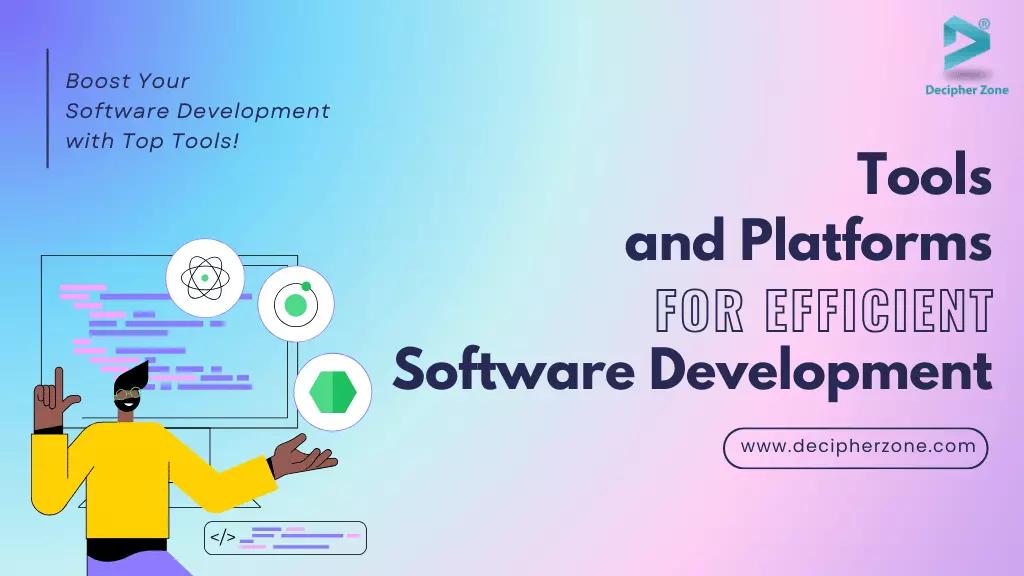You need the right set of software development tools to make your development faster, improve collaboration, and boost code quality. With the best software development tools you can create tailored software solutions that are not only scalable but will keep your business on a competitive edge. This blog will cover the top 20 software development tools and platforms to choose from for the future development of your successful idea.
The right tools and platforms developers use go beyond convenience and can significantly impact their productivity and the quality of their work. Choosing the right tools can streamline workflow, improve collaboration across teams, and elevate code quality, making development faster and more reliable.
Whether you are debugging complex systems, managing projects, or collaborating with distributed teams, there is a growing demand for efficient, scalable, and user-friendly applications. This blog explores the top 20 tools and platforms shaping modern software development.
From project management to version control, code editors, and deployment platforms, this guide is structured to help you discover tools tailored to your needs.
20 Best Tools and Platforms for Effective Software Development in 2025
The tools and platforms are divided into various categories like version control, integration development, project management, CI/CD, code quality, cloud computing, design, and prototyping.
Essential Tools for Version Control and Collaboration
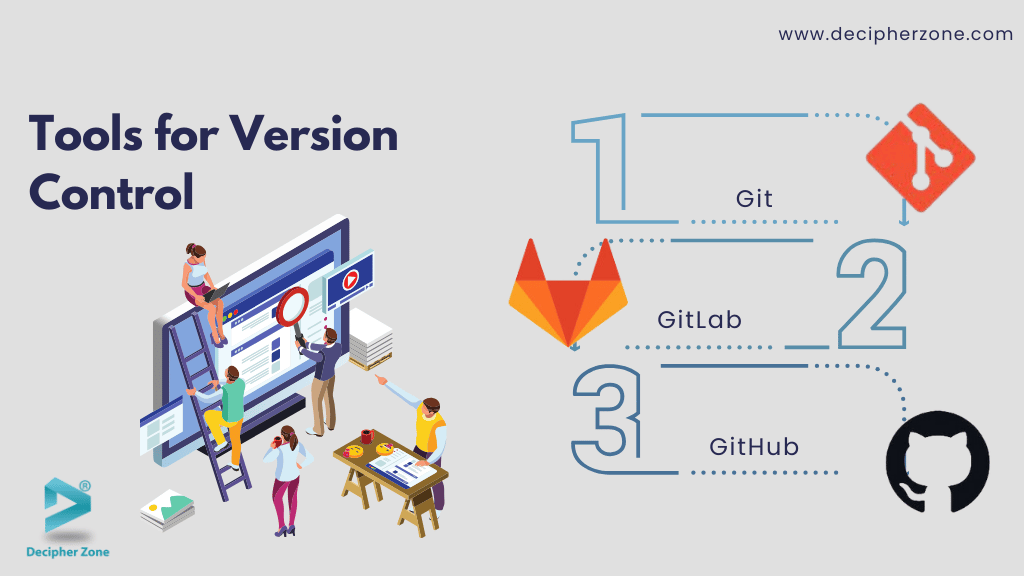
Version control allows developers to track changes, collaborate with team members, and maintain a stable codebase. To stay organized and efficient version control is a crucial aspect of software development.
1. Git
Git is mostly used by developers, allowing multiple developers to work on a project simultaneously without interfering with each other’s work. This makes it an essential tool for large-scale and collaborative software development projects.
Key Features:
-
Developers have distributed version control which allows developers for offline work and better resilience.
-
To enable smooth workflows and collaboration developers can create branches for new features or bug fixes and then merge them into the main codebase.
-
Git is known for its fast performance which makes it suitable for large projects with many files.
-
Git offers a staging area where developers can review changes before committing them which reduces errors and ensures precision.
2. GitLab
GitLab offers version control along with additional features which is basically a web-based DevOps lifestyle tool. This provides a single application for the entire DevOps process. This helps the team streamline their development and deployment pipeline.
Key Features:
-
GitLab allows teams to automate testing, building, and deploying code as it has built-in support for continuous integrations and continuous deployment.
-
Developers review and discuss changes before they are merged into the main codebase with GitLab’s merge request features.
-
It provides advanced security features including code quality analysis, vulnerability scanning, and audit logs.
3. GitHub
GitHub is built on top of Git and provides additional features to help developers collaborate, share code, and build open-source projects. This is one of the most widely used platforms for version control and collaboration.
Key Features:
-
GitHub makes it easy to manage code changes and collaborate on projects utilizing powerful version control features.
-
It allows multiple developers to work together on a project which provides features like pull requests, code reviews, and discussions to make sure the collaboration is smooth.
-
To enhance the development workflow, GitHub integrates with a variety of tools, from project management software to continuous integration services.
-
With GitHub Actions feature allows developers to automate workflows from testing to deployment directly within the GitHub environment.
Top Integrated Development Environments (IDEs) for 2025
IDEs offer a comprehensive suite of tools for writing, debugging, and testing code. Here are the three most popular and powerful IDEs that have redefined how developers work.
.avif)
4. Visual Studio Code
Whether you are working on web development, mobile applications, or AI projects, Visual Studio code has got you covered. Basically, it is a powerful code editor that offers developers extensive customization options, speed, and versatility.
Key Features:
-
Visual Studio Code provides intelligent code completion, parameter info, and quick info as developers type.
-
Being a versatile tool for developers it supports a wide range of programming languages and frameworks.
-
It allows developers to manage repositories, save changes, and push updates without switching applications.
-
It boosts real-time collaboration with team members directly within the editor.
5. JetBrains IntelliJ IDEA
JetBrains IDEs provide robust features, intelligent code assistance, and strong refactoring tools which include IntelliJ IDEA, PyCharm, WebStorm, and others. These are the popular choices of developers seeking powerful, language-specific development experience.
Key Features:
-
This intelligence coding assistance offers smart code completion, on-the-fly code analysis, and refactoring tools to speed up development.
-
For full-stack developers, some popular frameworks like Spring, Hibernate, and JavaFX offer comprehensive support for improving productivity.
-
It provides seamless integration with Git, GitHub, GitLab, and other version control systems for efficient team collaboration.
-
This is a one-stop solution for developers with built-in tools for database management, terminal access, and profiling.
6. Eclipse
Eclipse IDE is widely used for Java development which supports other languages through plugins. It offers a rich set of tools that is suitable for individual developers and large software development teams working on complex, multi-language projects.
Key Features:
-
Eclipse IDE provides a highly customizable workspace to suit individual workflows and project requirements.
-
With powerful debugging and unit testing tools that allow developers to deliver high-quality software.
-
The Plugin ecosystem allows developers to add functionalities such as additional language support, modeling tools, and build automation.
-
The Eclipse is backed by a large open-source community that offers extensive documentation, tutorials, and support.
Project Management and Collaboration Tools for Developers
Project management and collaboration tools allow developers to manage tasks, collaborate with team members, and keep track of projects. Effective project management and seamless collaboration are essential for effective software development.
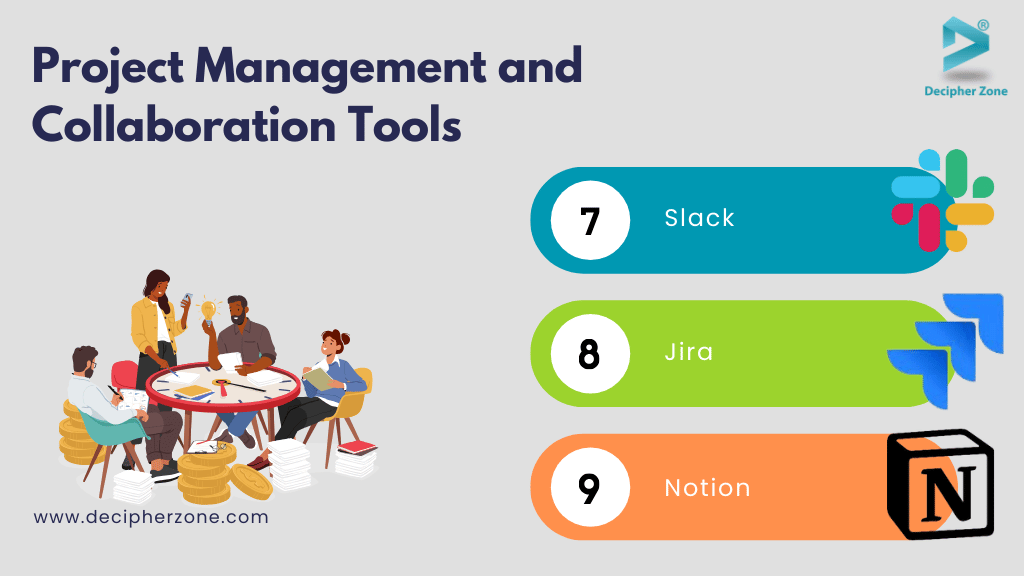
7. Slack
Slack is a powerful cloud-based platform designed to facilitate real-time collaboration among the development team. It integrates smoothly with various development tools that ensure the team is updated and aligned throughout the development process.
Key Features:
-
Slack offers real-time messaging with team members and is complete with support for multimedia messages, emojis, and reactions.
-
It allows the creation of channels for teams, projects, or topics to keep discussions organized and focused.
-
It stores all messages, files, and links to make it easy to search and retrieve past conversations.
-
It offers a feature to keep control based on priorities on topic by customizing notifications.
8. Jira
Jira is a project management and issue-tracking tool, designed to help the development team plan, track, and release software solutions efficiently. It provides robust features and customizable workflows making it widely used for agile project software development and popular among businesses of all sizes.
Key Features:
-
Jira supports Srum and Kanban boards for managing workflows and sprints.
-
It allows developers to visualize roadmaps to plan and communicate project goals and progress.
-
Easy integration with tools like Bitbucket, Git, and CI/CD pipelines to streamline development workflow.
-
It provides advanced reporting insights into team performance and project health through detailed reports and dashboards.
9. Notion
Developers use Notion to document processes, organize projects, and collaborate effectively. Basically, Notion is an all-in-one workspace that combines note-taking, task management, and collaboration into a single platform.
Key Features:
-
Notion offers customizable templates to create or use for project planning, sprint retrospectives, or technical documentation.
-
It provides real-time collaboration with instant updates, and comment features that make sure the team members work on the same page.
-
Integrating with development tools including Slack, Jira, or GitHub for a unified workflow.
The Best CI/CD Tools for Continuous Integration and Deployment
Continuous Integration and Continuous Deployment (CI/CD) tools automate the process of testing, building, and deploying code. This provides a smooth and efficient pipeline. Below are the three powerful CI/CD tools that can revolutionize your workflow.
_Tools.avif)
10. Jenkins
Jenkins is an open-source automation server that allows developers to automate all stages of the software development life cycle, from code integration to deployment, with ease. This makes it essential for DevOps workflow and large-scale, collaborative projects.
Key Features:
-
Jenkins allows to integrate with virtually any tool or platform in their tech stack with over 1,800 plugins.
-
It supports pipelines-as-code with its declarative syntax which makes it easier to manage and version control build pipelines.
-
Provides cross-platform compatibility for diverse development environments.
-
It maximizes efficiency by tailoring Jenkins pipelines to suit complex workflows.
11. CircleCI
CircleCi is a cloud-based CI/CD tool designed for speed and simplicity enabling the automation of the build process. Developers can compile and package applications with no manual input, reducing the time they spend on integration and deployment tasks. CircleCI provides robust performance for containerized applications and microservices.
Key Features:
-
CircleCI ensures rapid feedback during the development process by optimizing build times using parallelism and catching.
-
Developers can choose between using CircleCI’s cloud-hosting service or setting up an on-premise solution for added control.
-
It runs automated testing across multiple environments which ensures code quality and reduces the risks of bugs in production.
12. AWS Build Pipeline
AWS Build Pipeline is Amazon’s fully managed CI/CD service that integrates with the AWS ecosystem, allowing developers to automate build, test, and deployment workflows for applications hosted on AWS.
Key Features:
-
To streamline workflow for cloud-based applications, AWS Build Pipeline works natively with other AWS services.
-
The tool automatically scales to handle large workloads, making it ideal for large projects.
-
Developers can use AWS CloudFormation to define and manage pipelines, ensuring consistency and version control.
-
With Pay-as-You-Go pricing, developers only pay for the resources they use which makes it cost-effective.
Code Quality and Debugging Tools for Reliable Software Development
Mainly developers rely on specialized tools to identify errors, optimize performance, and make sure code adheres to best practices. Maintaining high code quality and debugging efficiently is critical to building robust and reliable applications. Here are three indispensable tools for code quality and debugging,
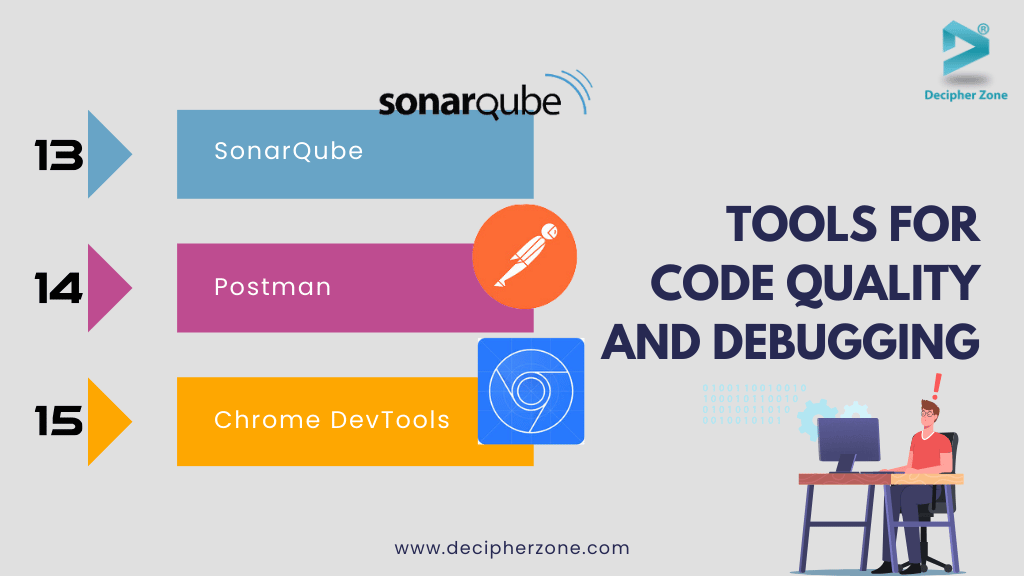
13. SonarQube
SonarQube is a leading platform for continuous code quality inspection. It analyzes the source code, identifies vulnerabilities, and ensures that the codebase follows clean code principles. SonarQube supports multiple programming languages and integrates smoothly with CI/CD pipelines. This makes it a must-have for maintaining code health.
Key Features:
-
It supports programming language which makes it versatile for diverse projects.
-
Developers can enforce standards using quality gates, ensuring code meets the defined goals before merging.
-
It detects security vulnerabilities, helping developers adhere to OWASP and other security standards.
-
SonarQube’s plugin ecosystem allows teams to extend its functionality to suit their needs.
14. Postman
Postman is a collaboration platform and API testing tool designed to simplify API development by providing a powerful suite of tools for designing, testing, and monitoring APIs. Its intuitive interface allows developers to create requests, inspect responses, and automate testing which makes it an essential tool for teams working with APIs in development and QA.
Key Features:
-
Postman provides a streamlined API testing process that allows users to easily create HTTP requests, test endpoints, and inspect responses.
-
It offers a shared workspace to collaborate on API documentation, testing, and monitoring for teams which enhances productivity and consistency.
-
It supports environment variables for managing different configurations across development, staging, and production.
15. Chrome DevTools
Chrome DevTools is a built-in set of developer tools in the Chrome browser that offers a suite for debugging, profiling, and optimizing web applications. It is a staple for front-end developers looking to create performant and visually polished websites.
Key Features:
-
Developers can inspect and modify the DOM and CSS in real-time to troubleshoot layout and styling issues.
-
It includes tools for analyzing page load times, resource usage, and rendering performance to optimize speed.
-
Developers can emulate different devices and screen sizes to ensure responsive design.
-
Chrome DevTools includes a Lighthouse integration which is a tool for auditing the accessibility, performance, and SEO of web applications.
Cloud Computing and Deployment Tools for Scalable Software Development
Developers require vigorous tools for containerization, orchestration, and deployment to build, deploy, and scale applications seamlessly. Here are three essential tools for cloud computing and deployment that ensure efficiency and reliability.
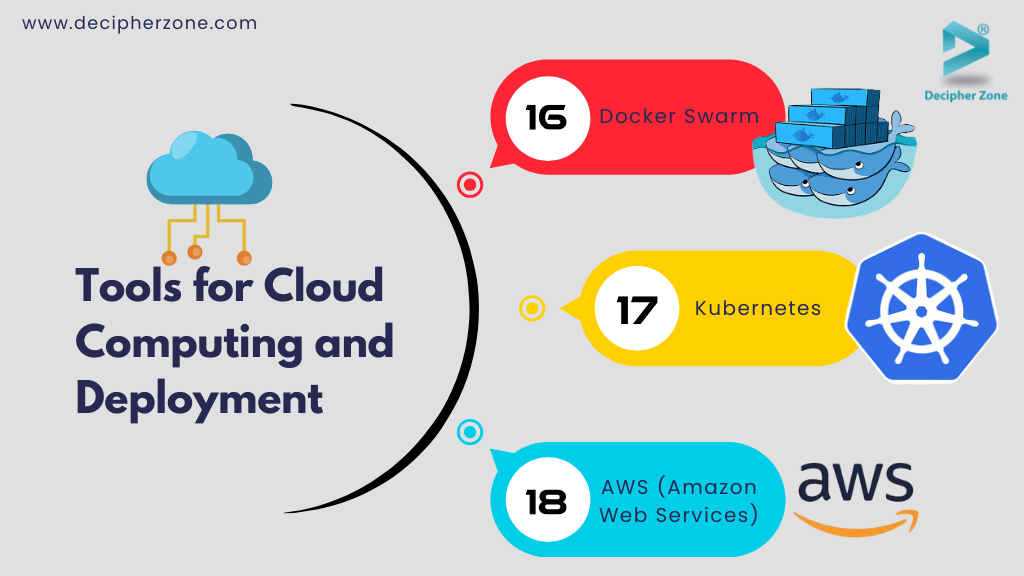
16. Docker Swarm
Docker Swarm is designed to simplify the deployment and management of containerized applications. This Docker’s native container orchestration tool allows developers to create and manage clusters of Docker nodes. This ensures high availability and scalability.
Key Features:
-
Developers can easily scale applications up or down by adjusting the number of replicas in a service.
-
Swarm mode guarantees fault tolerance by automatically redistributing services in case of node failures.
-
It provides simplified, secure, and straightforward networking options for container communication.
-
Developers can define application services in a YAML-based Compose file that makes easy to version and share configurations.
17. Kubernetes
Kubernetes is a leading open-source container orchestration platform. It automates the deployment, scaling, and management of containerized applications. Kubernetes provides a robust framework for managing clusters of containers which makes it essential for microservices architectures and environments which makes it a cornerstone of modern cloud-native development.
Key Features:
-
To manage traffic distribution effectively, Kubernetes offers built-in service discovery and load balancing.
-
It automatically scales applications based on resource usage or predefined conditions which ensure optimal performance.
-
It provides self-healing meaning the platform itself restarts failed containers and replaces unresponsive nodes. This makes sure the system is resilient.
-
For flexibility, it supports deployment across multiple cloud providers and on-premise environments.
18. AWS (Amazon Web Services)
AWS is a comprehensive cloud computing platform that offers a suite of services for infrastructure, storage, application deployment, computing power, specialized tools for AI, machine learning, analytics, and more. It allows developers and businesses to operate efficiently in the cloud with customizable applications globally.
Key Features:
-
Developers can launch and manage virtual servers with flexible Compute Cloud(EC2) options to meet demand.
-
It is ideal for event-driven architectures as a serverless computing service that lets developers run code without managing servers.
-
It offers advanced security features such as encryption, identity, and access management (IAM), and compliance certifications.
-
As per the global infrastructure, AWs ensure low latency and high availability for applications global network of data centers.
Design and Prototyping Tools for User-Centered Software Development
Creating visually appealing and user-friendly applications is essential to make it scalable. Design and prototyping tools help developers collaborate effectively with UX/UI designers and streamline workflows. They also ensure designs are functional and implementable. Here are two popular tools.
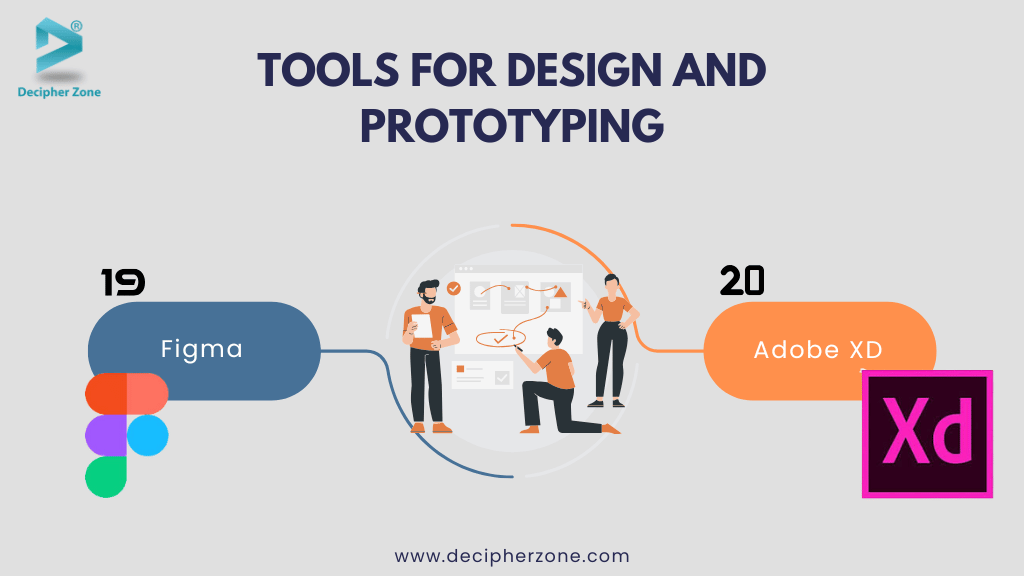
19. Figma
Figma allows developers and designers to collaborate in real-time, eliminating the need for downloads. It is a cloud-based design and prototyping tool that ensures seamless teamwork across distributed teams.
Key Features:
-
Figma reduces miscommunication with live collaboration which allows developers and designers to work together on the same project.
-
Developers can review and test clickable prototypes to understand workflows and navigation logic before implementation.
-
The Figma offers extensive plugins and friendly features that allow developers to do accessibility checks, automate repetitive tasks, and provide CSS code snippets and design specifications.
20. Adobe XD
Adobe XD is one of the Adobe products designed and tailored for creating wireframes, prototypes, and high-fidelity designs. It integrates seamlessly with other Adobe Creative Cloud applications.
Key Features:
-
Adobe XD provides a clean and user-friendly interface that allows developers and designers to create designs quickly and effectively.
-
To align functionality with design intent, developers can preview navigation flows and transitions through interactive prototypes.
-
It is cross-platform compatible and runs on both Windows and macOS with support for mobile previews on iOS and Android.
-
It integrated well with other Adobe tools like Photoshop and Illustrator which enhances productivity for teams using the Creative Cloud suite.
Final Thoughts
At Decipher Zone, we focus on a “Quality first” approach in every software development we undertake. This guide has the best tools, from managing projects and debugging code to deploying applications and designing prototypes.
Partnering with us can be beneficial to choosing the right combination of tools tailored to your requirements which will not only boost productivity but also improve innovation and scalability in your projects.
As we move into 2025, staying informed about the latest and best advancements and embracing tools that align with your goals will be key to maintaining a competitive edge.
Adopt, adapt, and evolve—these principles will guide you in making the most of the tools available today and those yet to come!

FAQs
-
What are the best software development tools for beginners?
Beginners often choose tools that are user-friendly and have extensive community support such as Visual Studio Code, GitHub, Figma, etc.
-
Can I use multiple tools for a single project?
Yes, you can use multiple tools for a single project as many tools complement each other. For example, you can use GitHub for version control, Visual Studio Code as your IDE, and Jira for project management.
-
Which is the best software development tool?
There is no best software development tool as the choice of tool depends on multiple factors including application type, features required, capabilities of the developer, and the existing tech stack in the organization. Considering your requirements, you can get the best yet latest software development tool to create an intuitive and scalable software solution.

